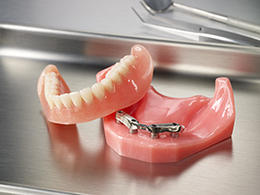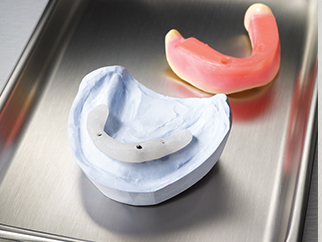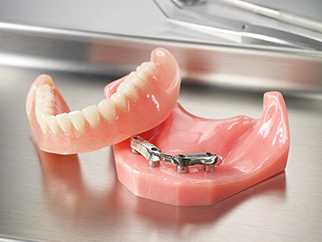Overdenture
Overdenture can be made to fit over a bar or to work with attachments.

Bar Overdenture
For edentulous patients desiring a stable, aesthetic prosthesis, the Implant Bar Overdenture could be the perfect choice to help improve retention, function and speech. A Bar Overdenture connects the patient’s implants to each other via a fabricated bar that helps protect the individual implants by spreading out the bite load. The complete denture then fits securely over the implants for great stability.
Advantages
- Distributes occlusal loads more evenly across all the implants
- Restricts movement of the complete denture
- Provides a stable option for patients with missing teeth
- Supports the denture while taking pressure off the gum tissue
- Provides for better retention and comfort than a conventional denture
Indications
- For patients with a heavy bite
- When the implants have been placed in softer bone
- When significant bone loss has occurred and there is not enough ridge height to provide lateral resistance
Dental Insurance Codes
- D6920 - Connector bar - A device attached to a fixed partial denture retainer or coping which serves to stabilize and anchor a removable overdenture prosthesis.

Attachment Overdenture
NDX has extensive experience working with direct-to-implant attachments, including the popular Zest Anchor locator abutments. Direct attachments can be a more-affordable option for non-splinted restorations.
Indications
- Oral irritations or bone loss for denture fixation
- Edentulous patients with a cleft palate
- Economic constraints
Dental Insurance Codes
- D5862 - Precision attachment, by report - Each set of male and female components should be reported as one precision attachment. Describe the type of attachment used.
- D5867 - Replacement of replaceable part of semi-precision or precision attachment (male or female component)
